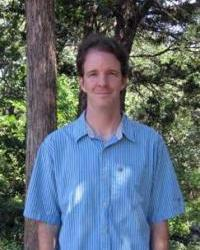Barney Luttbeg, Associate Professor.
Behavioral Ecology, Theoretical Ecology, Predator-prey Interactions, Mate Choice, Plasticity
Ph.D., 1997, University of California , Davis
Phone: 405-744-1717
Email: luttbeg@okstate.edu
Specific Interests
I am primarily a behavioral ecologist and the majority of my research boils down to how do individuals assess and react to their environments. I am interested how individuals should gather and use information to estimate the current state of their environment and respond with flexible behavior or morphology. My work started with questions about how females when selecting a mate should optimally gather information about potential mates. I did my PhD at the University of California at Davis with Dr. Marc Mangel. For my PhD work, I used a Bayesian framework to think about how individuals should use imperfect information when making a decision, and I studied how female threespine sticklebacks in Alaska assess males before choosing a mate.
During my post-doc years, I changed my focus to studying how prey respond to varying predation risk, however the fundamental question remained how to optimally live in varying world when only imperfect information is available. I was a post-doc at Yale University and worked with Dr. Oswald Schmitz to investigate how flexible prey behavior affects predator and prey population dynamics. I was then a post-doc at the National Center for Ecological Analysis and Synthesis (NCEAS) where I was a member of a working group exploring the rise of new statistical approaches for studying ecology. After a one-year stint teaching ecology at the Kellogg Biological Station, I started a post-doc (and eventually a research scientist position) with Dr. Andy Sih at the University of California at Davis. Andy and I have worked on several collaborations, but the primary work that I did as a post-doc was developing theory and doing experiments to investigate the dynamics of how the spatial distributions prey and predators are shaped by this interaction of prey and predator behaviors.
Since I began my faculty position at Oklahoma State University in 2008, with graduate and undergraduate students I have continued to investigate how information and the lack of information shape the behaviors of individuals and the dynamics of systems. Studies have included the effects of contaminants on behavior and life history decisions in tadpoles and snails, how male signals and female preferences affect speciation in katydids, and the diversity of color signals and their effects on conflict and mate choice in burying beetles.
Currently my lab is primarily focus on the behavior and morphology of a freshwater snail, Physa acuta. We are interested in how the snails respond behaviorally and morphological to the varying levels of predation risk primarily from crayfish. Part of our focus has been on presence of transgenerational effects, where a parent being exposed to predation risk affects the phenotypes of their subsequent offspring. We are currently investigating how those transgenerational effects differ between mothers and fathers and how those effects interact.
A new interest of mine is what we are calling safety cues. Our definition of a safety cue is a cue that gives more precise information for lower levels of predation risk than for high levels of predation risk. The opposite are danger cues that give more precise information about high levels of predation risk. We have shown that safety cues in many circumstances give prey more valuable information than danger cues. We are testing whether Physa acuta pay attention to safety cues and how they affect their metabolism and success.
If you are interested in joining my lab, please send me an email.
Selected Publications
- Luttbeg B, Ferrari MCO, Blumstein DT, and Chivers DP. 2020. Safety cues can give prey more valuable information than danger cues. The American Naturalist 195:636-648.
- Donelan SC, Hellmann JK, Bell AM, Luttbeg B, Orrock JL, Sheriff MJ, and Sih A. 2020. Transgenerational plasticity in human-altered environments. Trends in Ecology and Evolution 35:115-124.
- Goeppner SR, Roberts ME, Beaty LE, and Luttbeg B. 2020. Freshwater snail responses to fish predation integrate phenotypic plasticity and local adaptation. Aquatic Ecology 54:309-322.
- Wormington JD, Luttbeg B. 2019. Disrupting information alters the behavioral responses to a mutual signal trait in both sexes of Nicrophorus (Coleoptera: Silphidae) burying beetles. Behavioral Ecology 30:960-967.
- Guariento RD, Luttbeg B, Carneiro LS, and Caliman A. 2018. Prey adaptive behaviour under predation risk modify stoichiometry predictions of predator-induced stress paradigms. Functional Ecology 32:1631-1643.
- Luttbeg B. 2017. Re-examining the causes and mechanisms of the risk allocation hypothesis. The American Naturalist 189:644-656.
- Beaty L, Wormington J, Kensinger B, Bayley K, Goeppner S, Gustafson K, and Luttbeg B. 2016. Shaped by the past, acting in the present: transgenerational plasticity of anti-predatory traits. Oikos 125:1570-1574.
- Matassa C, Donelan S, Luttbeg B, and Trussell GC. 2016. Resource levels and prey state influence antipredator behavior and the strength of nonconsumptive predator effects. Oikos 125:1478-1488.
- Luttbeg B, Trussell GC. 2013. How the informational environment shapes how prey estimate predation risk and the resulting indirect effects of predators. The American Naturalist 181:182-194.
- Luttbeg B, Sih A. 2010. Risk, resources and state-dependent adaptive behavioural syndromes. Philosophical Transactions of the Royal Society B, 365:397-3990.
- Hammond JI, Luttbeg B, Sih A. 2007. Predator and prey space use: dragonflies and tadpoles in an interactive game. Ecology, 88:1525-1535.
- Luttbeg B. 2004. Female mate assessment and choice behavior affect the frequency of alternative male mating tactics. Behavioral Ecology, 15:239-247.
- Luttbeg B, Langen TA. 2004. Comparing alternative models to empirical data: cognitive models of Western Scrub-jay foraging behavior. The American Naturalist, 163:263-276.
- Luttbeg B, Rowe L, Mangel M. 2003. Prey state and experimental design affect relative size of trait-mediated and density-mediated indirect effects. Ecology, 84:1140-1150 (Special Feature).
- Luttbeg B, Schmitz OJ. 2000. Predator and prey models with flexible individual behavior and imperfect information. The American Naturalist, 155:669-683.
- Luttbeg B. 1996. A Comparative Bayes tactic for mate assessment and choice. Behavioral Ecology, 7:451-460.

